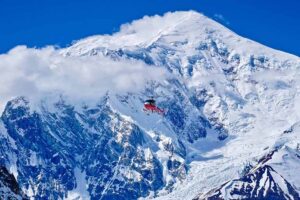We caught up with Jost Kobusch during a change of flights at the Paris airport, to find out more details about his solo Denali climb last week. We especially wanted to understand why he took the descent route he did from the summit.
Kobusch had chosen winter Denali as a test before returning to winter Everest, his grand project. He wanted to test himself against cold, darkness, and isolation on the roof of Alaska, solo and in winter.
“It’s hard to say how hard it was, because Denali is not a technical climb, except maybe one very icy section on the upper part of the Messner Couloir,” he explained. “Its hardship is mainly about the dimensions of the mountain. It’s huge! On Everest, there are 3,500 vertical meters from Base Camp to summit. On Denali, it’s even higher — 4,000 vertical meters. And the distances to get anywhere are so, so long.”
Comparing the two mountains, Kobusch notes that Denali is darker and temperatures at its base are colder.
“It can be easily -40º in Base Camp,” he said. “At their summits, both Everest and Denali are in the jet stream, which creates extreme winds.”

The Messner Couloir route on Denali’s 3D image by FATMAP. The point marked as Camp 4 is usually a fifth high camp set by West Buttress climbers before the final summit day.
Summit day and night
On Denali, Kobusch wanted to discover what was too cold to endure. He learned that lesson on Feb. 19, summit day. At the time, those of us following him from home were confused because of his unclear GPS track. It turned out that Kobusch spent too little time on the summit for his InReach to register the summit point. Considering the conditions he described, it’s no wonder he didn’t linger.
“The start of the Messner Couloir was very icy, around grade WI-2, and therefore unsuitable as a camping spot,” Kobusch wrote on social media. “This is why I decided to go for the summit in one single push on a long summit day.
“On the summit, I couldn’t measure the exact temperature, but according to weather reports, it was -45ºC and [winds of] 50kph,” Kobusch told ExplorersWeb. According to the U.S. National Weather Service calculator, that makes a windchill of -69ºC (-93˚F).
Kobusch’s top priority was to keep moving all the time, just to stay warm:
” if you start too early on Denali, it’s very difficult to get the body temperature up — so that’s why I decided to go for a later start and then use the night as my summit window. I knew that by the time I reached the summit, my body would be warm enough.”
The descent
He only decided on his descent route as he exited the Messner Couloir and approached the summit in high winds.
“At that moment, I was aware that the wind was too strong to downclimb the icy sections of the Messner Couloir, so it just felt safer to me to descend down the West Buttress route, which I did, until eventually…I took a wrong turn!”

Kobusch’s track, showing him back to the 14,200-foot camp (4,330m).
“I had never been on the mountain before, and at Denali Pass, I descended down a technical ice couloir toward the 14,200-foot camp,” Kobusch explained. “It is not the regular West Buttress variation down from the summit, it’s just the descent line I saw most fit at the moment.”
Ready for Everest
As for his longer-term project of soloing Everest in winter, Kobusch declared himself ready.
For now, Kobusch needs to recover from Denali. “It has been demanding on my body. I’ve lost quite a bit of weight and it is time to regain all of that,” he said. “I’ll be in Chamonix for the next few months. I want to train, enjoy the mountains…And then at the end of the year, I’ll head for Everest.”

File image of Jost Kobusch on his latest attempt to solo Everest, in January 2022. Photo: @terragraphy





